Where did the
much-overused phrase “the red carpet treatment” originate? It all
started with the 20th Century Limited, the New York Central
Railroad’s high speed overnight Pullman train between New York and
Chicago.

At each New York departure, Red Cap attendants at Grand Central
Station rolled out a crimson carpet for passengers boarding the
all-Pullman streamliner for Chicago. From 1938 until the last run in
1968, passengers walked down this carpet to their waiting cars.
Stretching from the observation car to the engine, the football
field length rug, especially designed for the Century, gave birth to
the phrase “the red carpet treatment."
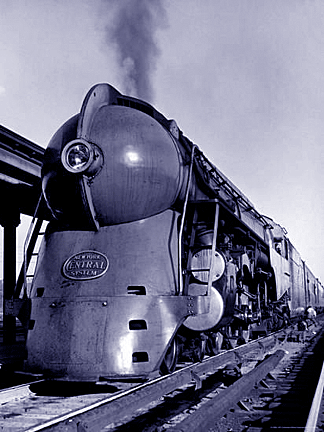 The
glamorous departure aboard New York Central’s 20th Century Limited
equaled a sailing on the Queen Mary. Pullman was the only way to
travel overnight by train in America. At each departure, attendants
gave carnations to male passengers and flowers and perfume to the
ladies. Porters helped passengers to board while waiters stood at
attention in the dining cars while chefs busily prepared the
evening’s dinner.
The
glamorous departure aboard New York Central’s 20th Century Limited
equaled a sailing on the Queen Mary. Pullman was the only way to
travel overnight by train in America. At each departure, attendants
gave carnations to male passengers and flowers and perfume to the
ladies. Porters helped passengers to board while waiters stood at
attention in the dining cars while chefs busily prepared the
evening’s dinner.
It took less than 16 hours each way for the train to travel between
the two cities along the New York Central’s “Water Level Route,”
ensuring passengers a smooth and swift ride. The railroad
inaugurated this train, targeted at upper class and business
travelers, to compete against the Pennsylvania Railroad which ran
along a more mountainous route. It made few station stops along the
way and used track pans to take water at speed.
 The
Century departed New York’s Grand Central Station at 6 P.M. and
arrived the next morning at Chicago’s La Salle Street Station at
8:45 A.M. After boarding, passengers settled in for the evening,
enjoying cocktails in the observation car, dinner with views of the
Hudson, a good night sleep and then with breakfast in bed or in the
dining car. Dress was business formal.
The
Century departed New York’s Grand Central Station at 6 P.M. and
arrived the next morning at Chicago’s La Salle Street Station at
8:45 A.M. After boarding, passengers settled in for the evening,
enjoying cocktails in the observation car, dinner with views of the
Hudson, a good night sleep and then with breakfast in bed or in the
dining car. Dress was business formal.
In the 1920s the New York-Chicago fare was $32.70 plus the extra
fare of $9.60, plus the Pullman charge of $9 for a lower berth, for
a total of $51.30. For that passengers received a bed closed off
from the aisle by curtains—a private compartment cost more. In 1928,
the peak year, the train earned revenue of $10 million and was
believed to be the most profitable train in the world.
The Dining Cars
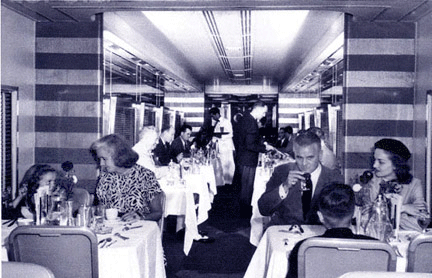 Built
by the Pullman-Standard Car Manufacturing Company, the train’s two
dining cars, aptly named The Century Club, each had four distinctive
dining sections, seating 64 persons at tables at one time, a
lounging ante-room and a steward's office. They came equipped with
radios, automatic record changing phonographs and lighting systems
by which the cars can be either brightly or dimly illuminated. In
the observation car, which also had a radio, a speedometer had been
installed for the speed fans.
Built
by the Pullman-Standard Car Manufacturing Company, the train’s two
dining cars, aptly named The Century Club, each had four distinctive
dining sections, seating 64 persons at tables at one time, a
lounging ante-room and a steward's office. They came equipped with
radios, automatic record changing phonographs and lighting systems
by which the cars can be either brightly or dimly illuminated. In
the observation car, which also had a radio, a speedometer had been
installed for the speed fans.
The New York Central spared no expense with the cars’ decoration,
commissioning industrial designer Henry Dreyfuss to design the menu
covers including the matchbook covers, as well as the table linens,
silver, and china. The menu included caviar, filet mignon and
lobster.
Menu prices in 1939 included the 20th Century Dinner for $1.75 with
Canape of Russian Caviar as a starter. Passengers could enjoy Filet
Mignon for an extra 60 cents, and enjoyed traditional American Apple
Pie topped with New York Central French Vanilla Ice Cream.
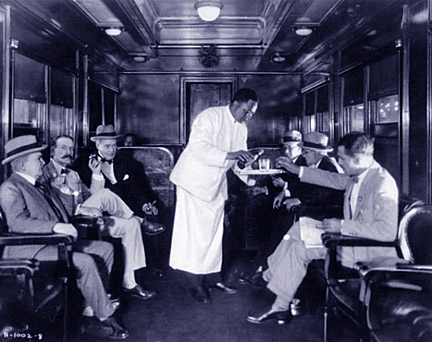 The
dining car stewards had notebooks filled with their particular meal
and drink requests. One of them claimed he knew 75 per cent of the
passengers and could call 15,000 people by their name. He knew that
Marshall Field would order one martini but expected to find two in
the shaker, Bing Crosby liked his wheat cakes piping hot at 6 A.M.
and Robert R. McCormick wanted apple pie a la mode.
The
dining car stewards had notebooks filled with their particular meal
and drink requests. One of them claimed he knew 75 per cent of the
passengers and could call 15,000 people by their name. He knew that
Marshall Field would order one martini but expected to find two in
the shaker, Bing Crosby liked his wheat cakes piping hot at 6 A.M.
and Robert R. McCormick wanted apple pie a la mode.
Bartenders in the three club cars took orders for Manhattans, Scotch
highballs and very dry Martinis from Chicago meatpacking executives
headed for New York. The train’s crew estimated that passengers
consumed 50 per cent of the cocktails sold in private rooms and
suites.
Passenger “A” List
 The
railroad kept passenger lists for each “sailing” of the Century. Bob
Hope, Bette Davis or Doris Day might be aboard. But the Century was
really the train for Chicago’s elite. The Wrigleys, Blairs, Bards,
and Fields were “the Century regulars” and occupied the bedroom
suites, compartments and drawing rooms.
The
railroad kept passenger lists for each “sailing” of the Century. Bob
Hope, Bette Davis or Doris Day might be aboard. But the Century was
really the train for Chicago’s elite. The Wrigleys, Blairs, Bards,
and Fields were “the Century regulars” and occupied the bedroom
suites, compartments and drawing rooms.
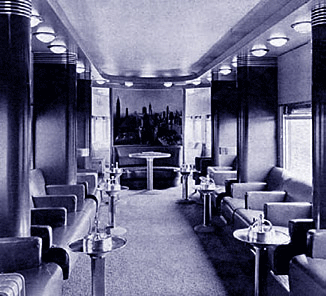 The
20th Century Limited was a repository of the coming and goings of
the rich–their habits of dress or drinking, their minds and their
manners. The Century was operated like a private club and the
lengthy dining car aptly named the Century Club. To businessmen, the
Century was a symbol of the immutable fulfillment of a scheduled
pattern; to luxury travelers it was the last word in conservative
opulence.
The
20th Century Limited was a repository of the coming and goings of
the rich–their habits of dress or drinking, their minds and their
manners. The Century was operated like a private club and the
lengthy dining car aptly named the Century Club. To businessmen, the
Century was a symbol of the immutable fulfillment of a scheduled
pattern; to luxury travelers it was the last word in conservative
opulence.
Regular passengers included Theodore Roosevelt, William Jennings
Bryan, Lillian Russell, "Diamond Jim" Brady, J. P. Morgan, Enrico
Caruso, and Nellie Melba.
Businessmen could enjoy a shave from one of the Century barbers
while the train’s secretary made calls ahead to confirm business
appointments.
The Streamliner
In 1938, the New York Central commissioned Dreyfuss to design a new
streamlined train in the Art Deco style, replacing the traditional
black exterior of its other trains with two shades of gray, with
aluminum and blue striping running the entire length of the new
Century. It consisted of eight all-room Pullmans, accommodations
including snug roomettes, single and double bedrooms, compartments,
and drawing rooms, plus two dining cars. Built at a cost of
$6,162,000, the new train was an expression of the best engineering
talent of the railroad and the Pullman Company.
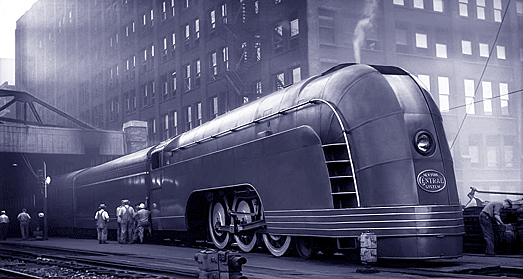
Dreyfuss decorated the interior of the new train in harmonizing
shades of blue, gray and rust with leather upholstery in the public
cars. He eliminated open berths , and sleeping accommodations are
provided in suites, double bedrooms compartments and roomettes, each
equipped with complete toilet facilities.
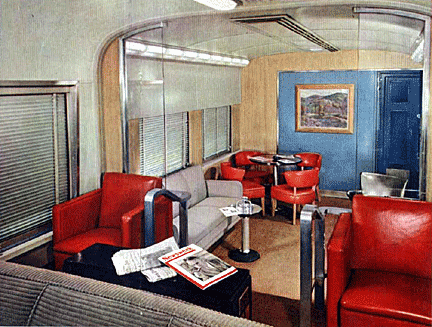 After
World War II, Dreyfuss designed a newer train, pulled by Diesel
locomotives. General Dwight D. Eisenhower ceremonially inaugurated
the new set in 1948 and actress Beatrice Lilly christened the
streamliner with a champagne bottle filled with water from the
Hudson, Lake Erie and Michigan symbolizing the “water level route.”
After
World War II, Dreyfuss designed a newer train, pulled by Diesel
locomotives. General Dwight D. Eisenhower ceremonially inaugurated
the new set in 1948 and actress Beatrice Lilly christened the
streamliner with a champagne bottle filled with water from the
Hudson, Lake Erie and Michigan symbolizing the “water level route.”
Few trains have carried the aura of Central's original streamlined
version of the Limited, which featured perhaps the greatest example
of shrouding ever applied to a steam locomotive. As flag bearer of
the "Great Steel Fleet" the Limited's service was second-to-none,
matched only by the Pennsylvania Railroad’s Broadway. As interest in
rail travel waned after World War II and a merger with the
Pennsylvania Railroad looming by the late 1960s, New York Central
chose to discontinue its once proud creation fearing service would
slip to unacceptable levels.
The Century made its final run on December 2, 1967. The half-filled
train left Grand Central Terminal on track 34 for the last time. As
always, attendants gave carnations to men boarding the train, and
perfume and flowers to the women. The next day, it straggled into
LaSalle Street Station in Chicago 9 hours 50 minutes late due to a
freight derailment near Conneaut, Ohio, necessitating a detour over
the Nickel Plate—New York, Chicago and St. Louis—Railroad.
